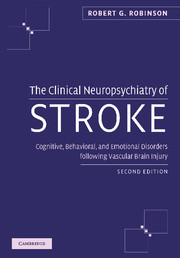 The Clinical Neuropsychiatry of Stroke
The Clinical Neuropsychiatry of Stroke Book contents
- Frontmatter
- Contents
- Preface
- Part I Introduction
- Part II Poststroke depression
- Part III Poststroke mania
- 24 Prevalence and clinical symptoms
- 25 Clinical and lesion correlates of poststroke mania
- 26 Bipolar disorder following stroke
- 27 Mechanism of mania following stroke
- 28 Treatment of mania following stroke
- Part IV Poststroke anxiety disorders
- Part V Other poststroke disorders
- Index
27 - Mechanism of mania following stroke
from Part III - Poststroke mania
Published online by Cambridge University Press: 01 October 2009
- Frontmatter
- Contents
- Preface
- Part I Introduction
- Part II Poststroke depression
- Part III Poststroke mania
- 24 Prevalence and clinical symptoms
- 25 Clinical and lesion correlates of poststroke mania
- 26 Bipolar disorder following stroke
- 27 Mechanism of mania following stroke
- 28 Treatment of mania following stroke
- Part IV Poststroke anxiety disorders
- Part V Other poststroke disorders
- Index
Summary
Injury to the inferior temporal cortex, orbital frontal cortex, caudate, and thalamus have all been demonstrated to lead to the development of mania in vulnerable patients. These constitute the major elements of the lateral orbital frontal circuit as described by Alexander et al. (1990) and the association of mania with injury to these structures suggests that these right hemisphere regions may play an important role in the mediation of mania following stroke.
One of the main factors, however, which must be taken into account in understanding the mechanism of poststroke mania is the lateralized effect of lesions. Hemispheric specialization and, therefore, the association with unilateral hemispheric lesions in secondary mania, appears to be even stronger than the lateralized effect in acute poststroke depression. Although the number of secondary mania cases is significantly less than the number of secondary depression cases, 21 out of 27 (78%) secondary mania cases that we have seen have had exclusively right hemisphere involvement compared to about 56% of patients with major depression who had exclusively left hemisphere lesions (see Chapter 10: “Relationship of depression to lesion location”). Five manic patients had midline or bilateral hemisphere involvement and only one patient had a localized left hemisphere lesion.
- Type
- Chapter
- Information
- The Clinical Neuropsychiatry of StrokeCognitive, Behavioral and Emotional Disorders following Vascular Brain Injury, pp. 306 - 313Publisher: Cambridge University PressPrint publication year: 2006
- 1
- Cited by


